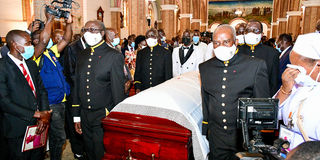How Catholics select a new archbishop

The body of Kampala Archbishop Cyprian Kizito Lwanga is wheeled into St Mary’s Cathedral, Rubaga in Kampala during the requiem Mass on Wednesday. PHOTO/ DAVID LUBOWA
What you need to know:
The Canon Law calls for consultations with the archbishop, bishops, the president of the national bishops’ conference on the choice of a bishop.
The Congregation for Bishops Directory for the pastoral ministry of bishops prepared by the Vatican states that an Episcopal See falls vacant upon the death or resignation of the incumbent, or upon transfer or privation made known to the bishop.
The directory says when a diocesan bishop dies, the See becomes vacant, and whoever assumes the interim governance of the diocese must inform the Holy See as soon as possible.
It also states that the coadjutor bishop immediately becomes the bishop of the diocese for which he had been appointed, provided that he has legitimately taken possession.
“Unless the Holy See has established otherwise, the auxiliary bishop, even one with special faculties, retains all the faculties that he possessed as vicar general or as episcopal vicar during the sede plena,” the directory states.
“If he is not elected diocesan administrator, he continues to exercise the same offices by force of law under the authority of the one who now presides over the governance of the diocese. It is desirable, however, that the auxiliary bishop should be elected to the office of diocesan administrator. If there are several auxiliaries, it is desirable that one of them should be so elected,” it adds.
The directory also states that the diocesan administrator should invite the priests, the parish communities and the religious to offer fervent prayers for the appointment of a bishop and for the needs of the diocese.
“In the cathedral and in all the other churches of the diocese, holy Mass for the election of a bishop is to be celebrated according to the formulary provided in the Roman Missal,” it says.
A guide published by Benedict T. Nguyen, the chancellor of Diocese of La Cross in the US, says appointment of the bishop is key because he is a successor to the apostles, the chief shepherd of a diocese and the visible source and foundation of unity in a diocese.
The guide says the process is regulated by canon law, the internal legal system of the Catholic Church, and Code of Canon Law.
It states that appointing and consecrating a new bishop normally requires at least nine months. In some occasions, it may take up to two years.
Wilkipedia states that the papal representative asks either the outgoing bishop, or in case of a sede vacante, the vicar general or diocesan administrator to draw up a report on its situation and the needs. The bishops of the ecclesiastical province or the whole Episcopal conference normally select lists of priests they judge to be suitable to become bishops, which by Canon Law, they are required to draw up at least once every three years.
Wilkipedia adds that when there is need to appoint a bishop, the Papal Nuncio, consults with various people for the names of qualified individuals.
According to the Canon Law, he should consult with the archbishop of the province, other bishops, the president of the national bishops’ conference and some members of the diocesan college of consultors. These are a group of priests selected from the diocesan priest council.
In addition, the Papal Nuncio is free to consult with others, including laity.
Wilkipedia states that Canon law insists on enabling those consulted to provide information and express their views confidentially, requiring that they be consulted “individually and in secret”. The nuncio then decides on a short list of three candidates for further investigation.
The Vatican director says the candidate must be at least 35 years old, and a priest for at least five years.
“He should be outstanding in strong faith, good morals, piety, zeal for souls, wisdom, prudence and human virtues, and should possess the other qualities needed for fulfilling the office in question; and he should be well versed in sacred scripture, theology and canon law and, preferably, hold a doctorate in one of these fields,” the guide says.
According to the guide, the nuncio will then send the list of three candidates to the Holy See together with all the information that has been gathered on them.
It says the congregation of the Roman curia, which is responsible for the appointment, will sit and study the documentation provided by the nuncio, taking into consideration his opinion, but not necessarily accepting it.
The directory, however, says the Roman curia is not bound by the opinion of the nuncio, and that it has the powers to reject all the candidates or some and request for a new list.
According to the directory, if the congregation agrees on the choice of the priest to appointed as a bishop, it will present this to the pope, requesting him to make the appointment
After conferring with the curia, the Papal Act is communicated to the nuncio, who is charged to obtain the consent of the priest before choosing a date for its publication.
“The newly appointed bishop is obliged to get episcopal consecration within three months of the arrival of the papal bull of his appointment, which is usually prepared at least a month after the publication. If the consecration takes place within the diocese, he takes charge immediately. If it occurs elsewhere, a separate act is required after the consecration for taking possession of his new post,” the guide states.


